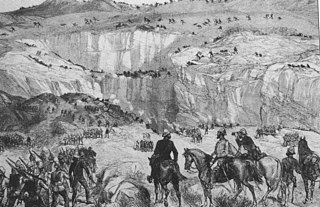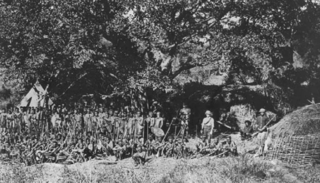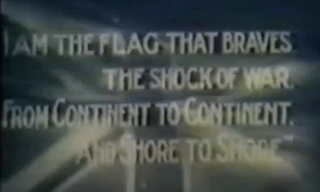Related Research Articles

The Anglo-Zulu War was fought in present-day South Africa from January to early July 1879 between forces of the British Empire and the Zulu Kingdom. Two famous battles of the war were the Zulu victory at Isandlwana and the British defence at Rorke's Drift.

Cetshwayo kaMpande was the king of the Zulu Kingdom from 1873 to 1884 and its Commander in Chief during the Anglo-Zulu War of 1879. His name has been transliterated as Cetawayo, Cetewayo, Cetywajo and Ketchwayo. Cetshwayo consistently opposed the war and sought fruitlessly to make peace with the British and was defeated and exiled following the Zulu defeat in the war. He was later allowed to return to Zululand, where he died in 1884.

Zibhebhu kaMaphitha Zulu was a Zulu chief. After the defeat of the Zulu Kingdom by the British, he attempted to create his own independent kingdom. From 1883 to 1884, he fought the Zulu king Cetshwayo, inflicting a series of defeats on him.

Nongoma is a town in Zululand, KwaZulu-Natal, South Africa. It is the seat of the Nongoma Local Municipality. It is situated 300 km north of Durban and 56 km from Ulundi; it is surrounded by the Ngome Forest. It is a busy market town that serves a large surrounding area. It is assigned registration plate NND.

The Battle of Ulundi took place at the Zulu capital of Ulundi on 4 July 1879 and was the last major battle of the Anglo-Zulu War. The British army broke the military power of the Zulu nation by defeating the main Zulu army and immediately afterwards capturing and burning the royal kraal of oNdini.

The Natal Native Contingent was a large force of auxiliary soldiers in British South Africa, forming a substantial portion of the defence forces of the British colony of Natal. The Contingent saw action during the 1879 Anglo-Zulu War. The Natal Mounted Police was created in 1873 to bolster the defenses of Natal. It enlisted European officers, NCOs and natives. The infantry was created in 1878. Most enlisted troops were drawn from the Basuto and Mpondo tribes, which had had long experience fighting the Zulus.
Battle of Inyezane, British victory during the early phase of the Anglo-Zulu war.

Dabulamanzi kaMpande was a Zulu commander for the Zulu kingdom in the Anglo-Zulu War. He is most noted for having commanded the Zulus at the Battle of Rorke's Drift. He was a half-brother of the Zulu king Cetshwayo.
The Mandlakazi are a Zulu clan in kwaZulu/Natal and formerly in Zululand. They started out as allies of Shaka as he founded the Zulu nation. The Mandlakazi derived wealth not only from cattle but from an extensive trade network that extended from northern Zululand north and east to Delagoa Bay in Mozambique.

The Battle of Ndondakusuka, often known as the Second Zulu Civil War, fought on 2 December 1856, was the culmination of a succession struggle in the Zulu Kingdom between Cetshwayo and Mbuyazi, the two eldest sons of the king Mpande. Mbuyazi was defeated at the battle and was killed, leaving Cetshwayo in de facto control of the kingdom, though his father remained king. Mbuyazi's followers, including five other sons of King Mpande, were massacred in the aftermath of the battle.

The 12 January 1879 action at Sihayo's Kraal was an early skirmish in the Anglo-Zulu War. The day after launching an invasion of Zululand, the British Lieutenant-General Lord Chelmsford led a reconnaissance in force against the kraal of Zulu Chief Sihayo kaXongo. This was intended to secure his left flank for an advance on the Zulu capital at Ulundi and as retribution against Sihayo for the incursion of his sons into the neighbouring British Colony of Natal.

The Natal Border Guard was an auxiliary force levied for the defence of the Colony of Natal during the Anglo-Zulu War of 1879. British military commander Lord Chelmsford had intended to raise a large auxiliary force to support his invasion of the Zulu Kingdom but was opposed by the civilian government of the Colony of Natal, led by its governor Henry Ernest Gascoyne Bulwer, who would have to finance the unit. Bulwer eventually allowed a smaller force to be raised with the stipulation that it not be deployed outside of Natal. This unit was to serve only on a part-time basis, receive no training and fight with the traditional weapons of spear and shield.

The Natal Native Pioneer Corps, commonly referred to as the Natal Pioneers, was a British unit of the Zulu War. Raised in November/December 1878 the unit served throughout the war of 1879 to provide engineering support to the British invasion of Zululand. Three companies were formed each comprising around 100 men and clad in old British Army uniforms. The units served at the battles of Isandlwana, Eshowe and Ulundi.
The abaQulusi or Qulusi are a zulu tribe from South Africa. They are based in the abaqulusi district, Kwazulu-Natal, that bears their name.
uHamu kaNzibe or Hamu kaNzibe was a Zulu chieftain, half-brother and great rival of king Cetshwayo.
Ian Knight is a British historian and writer, specialising in Anglo-Zulu and Boers wars.

Sihayo kaXongo was a Zulu inKosi (chief). In some contemporary British documents he is referred to as Sirhayo or Sirayo. He was an inDuna (commander) of the iNdabakawombe iButho and supported Cetshwayo in the 1856 Zulu Civil War. Under Cetshwayo, Sihayo was a chief of a key territory on the border with the British Colony of Natal and had a seat on the iBandla. Sihayo was an Anglophile who wore European clothes and maintained friendly relations with trader James Rorke who lived nearby at Rorke's Drift. By 1864, Sihayo was head of the Qungebe tribe and that year agreed a new western border of the kingdom with Boer leader Marthinus Wessel Pretorius.

Symbol of Sacrifice is a 1918 film dramatisation of the 1879 Anglo-Zulu War. It follows English soldier Preston Fanshall from the British defeat at the Battle of Isandlwana to Rorke's Drift where he participates in the successful defence of that post. His love interest, Marie Moxter, is captured by the Zulu during the battle and taken to their capital at Ulundi. Moxter's black servant, Goba, travels to Ulundi and intervenes to protect her from the advances of German villain Carl Schneider who has allied with the Zulu. The film shows the British defeat at the Battle of Hlobane and the arrival of reinforcements, including Napoléon, the French Prince Imperial. The prince becomes a central character for a portion of the film and is shown, in a lavish flashback, meeting Queen Victoria and Empress Eugénie at Windsor Castle. The death of the prince at the hands of the Zulu is shown. A second love triangle involving a Zulu woman, Melissa, with a warrior, Tambookie, and a villainous witchdoctor, is also depicted. The film ends with the British victory at the Battle of Ulundi, ending the war. Goba and Tambookie help Moxter to escape, but Goba is killed in the process and Tambookie enters Moxter's employment.

Lt Gen Richard Thomas Glyn was a British Army officer. He joined the 82nd Regiment of Foot by purchasing an ensign's commission in 1850. Glyn served with the regiment in the Crimean War and rose in rank to captain before transferring to the 24th Regiment of Foot in 1856. He served with that regiment in the Indian Mutiny and was appointed to command it in 1872. In 1875 he accompanied the 1st battalion of the regiment on service in the Cape Colony and fought with them in the 9th Cape Frontier War of 1877–78. He was appointed a Companion of the Order of the Bath after the war.

Fort Pearson was a fortification constructed by the British on the Natal side of the border with Zululand in the lead up to the 1879 Anglo-Zulu War. An earthen redoubt on a 300-foot (100 m) high cliff overlooking the Tugela River, the fort and its two external redoubts commanded an important river crossing. The crossing was used by one of the columns of the first invasion of January 1879, that was then besieged at Eshowe in Zululand. The crossing was used again by the Eshowe relief column in March and the second invasion in April. The fort was strengthened in April 1879 and connected to Pietermaritzburg by telegraph by June. The war was won by the British in July but the fort was briefly occupied again by British troops in 1883 during the Third Zulu Civil War.
References
- 1 2 "Archived copy". Archived from the original on 18 April 2019. Retrieved 4 July 2020.
{{cite web}}: CS1 maint: archived copy as title (link) - ↑ "GGEF". Archived from the original on 4 July 2020. Retrieved 4 July 2020.
- ↑ Library of Congress
- ↑ Laband, John (2017). The Assassination of King Shaka: Zulu History's Dramatic Moment. Jonathan Ball Publishers. p. 270. ISBN 978-1-86842-808-3.
- ↑ "The Fall of Rorke's Drift". Archived from the original on 7 July 2020. Retrieved 4 July 2020.
- ↑ Book review